Eels, a fascinating group of fish, belong to the order Anguilliformes, which encompasses around 1000 species spread across 20 families and 164 genera.
These captivating creatures can be found in various aquatic environments, ranging from freshwater rivers to tropical coral reefs and even the deepest parts of the ocean. Eels have intrigued humans for centuries with their elongated, snake-like bodies and diverse appearances.
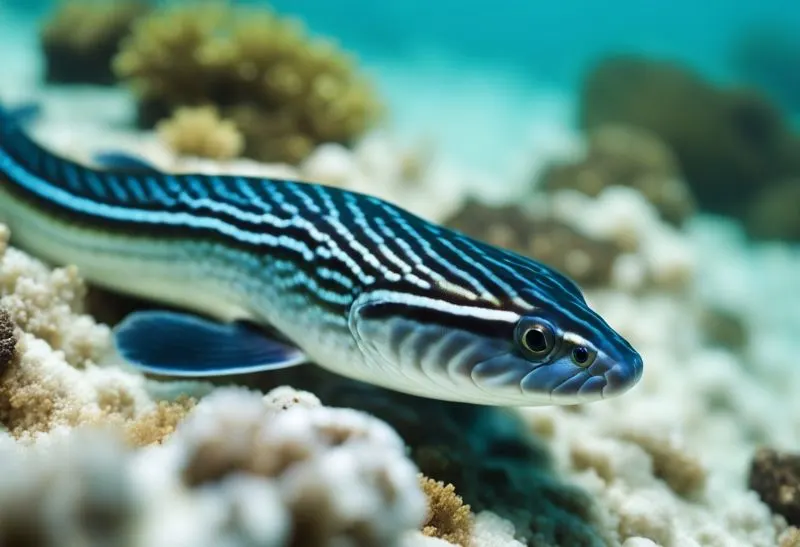
As predatory animals, eels have adapted to their respective ecosystems with unique features and behaviors. While some species display vibrant colors and patterns, others possess a more subdued appearance, helping them blend in with their surroundings.
Although they share a similar body shape, the different types of eels exhibit a remarkable variety in size, habits, and characteristics. This diversity makes studying eels an exciting and ever-evolving field in marine biology.
Among the notable eel families, Anguillidae comprises freshwater eels, Chlopsidae includes false morays, and Muraenidae features the well-known moray eels. Each of these families represents just a fraction of the vast array of eel types, showcasing the extraordinary scope and complexity of this incredible order of fish.
| Type of Eel | Scientific Name | Habitat | Diet |
|---|---|---|---|
| American Eel | Anguilla rostrata | North America | Carnivorous |
| European Eel | Anguilla anguilla | Europe | Carnivorous |
| Japanese Eel | Anguilla japonica | Asia | Carnivorous |
| Moray Eel | Gymnothorax javanicus | Tropical Seas Worldwide | Carnivorous |
| Electric Eel | Electrophorus electricus | South America | Carnivorous |
Different Types of Eels
Electric Eel
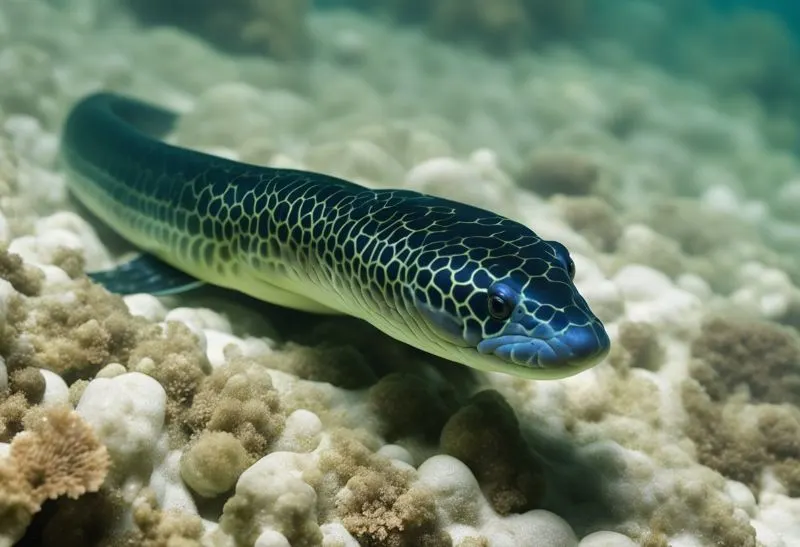
The Electric Eel (Electrophorus electricus) is a fascinating species that has captivated humans for centuries. Known for their powerful electric shocks, electric eels use this unique ability to navigate, communicate, and hunt prey. Native to the freshwater habitats of South America, these incredible creatures actually belong to the order Gymnotiformes, which makes them more closely related to the South American knifefishes than to true eels (Anguilliformes).
Electric eels are carnivorous predators that primarily prey on fish, amphibians, and invertebrates. They have a specialized organ composed of electrocytes capable of generating electric pulses for hunting and self-defense. The electric discharge can reach up to 860 volts, a powerful jolt that incapacitates or deters their opponents.
Due to recent research, scientists have discovered that the iconic electric eel is actually made up of three different species:
- Electrophorus electricus, the long-known electric eel
- Electrophorus voltai, named after the Italian physicist who built a battery based on the animal
- Electrophorus varii, named in honor of a prominent figure in ichthyology
This revelation of diversity within the electric eels’ genus has sparked interest to explore the unique properties of each species further. The newfound knowledge brings the potential for uncovering a broader range of bioactive substances and abilities, which could have various innovative applications in science and medicine.
In their natural habitat, electric eels can be found in slow-moving shallow waters, where they can easily navigate and search for prey. These creatures tend to thrive in swarms, which offers them greater protection and hunting capabilities. With an average life span of 15 years in the wild, electric eels live to continuously captivate scientists and nature enthusiasts with their unique characteristics and powerful abilities.
Giant Moray
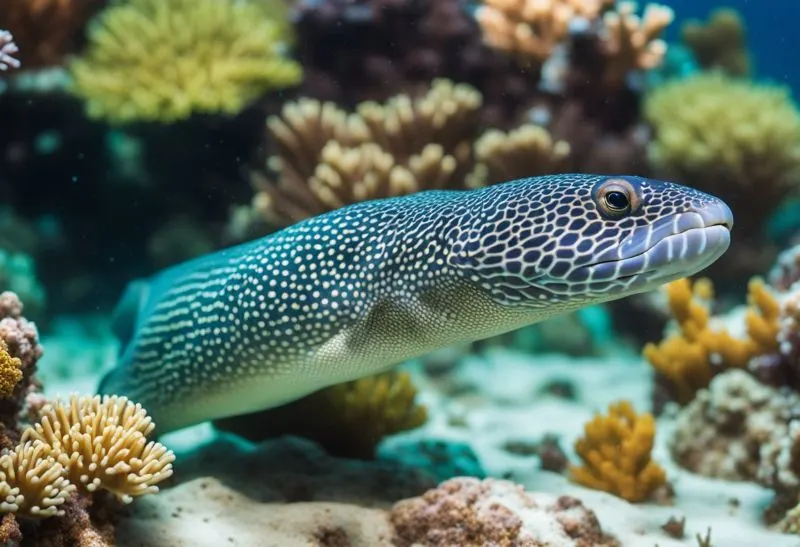
The slender Giant Moray eel (Gymnothorax javanicus) signifies a remarkable moray eel species inhabiting the Muraenidae family’s marine ecosystems. When it comes to body mass, this magnificent creature holds the title as the largest moray eel. However, the slender giant moray claims that distinct honor in terms of body length.
Distributed globally, moray eels encompass over 200 unique species typically in marine habitats, but some are also seen in brackish and freshwater environments. These beings are easily recognizable due to their colossal heads, vibrant color patterns, and the presence of pharyngeal jaws.
An interesting fact about the giant moray is that its body design enables it to adapt to various living conditions. It flourishes in coral reefs, rocky shorelines, and shallower waters. This astounding flexibility has allowed the giant moray to spread its awe-inspiring presence across the world’s oceans.
While the California moray eel (Gymnothorax mordax) holds exclusivity as the lone species found off the coast of California, other species like the snowflake moray demonstrate more docile, vibrant, and hardy characteristics. In contrast, the giant moray eel instills awe with its sheer size, making it a thrilling example of nature’s diverse aquatic offerings.
Grey Conger
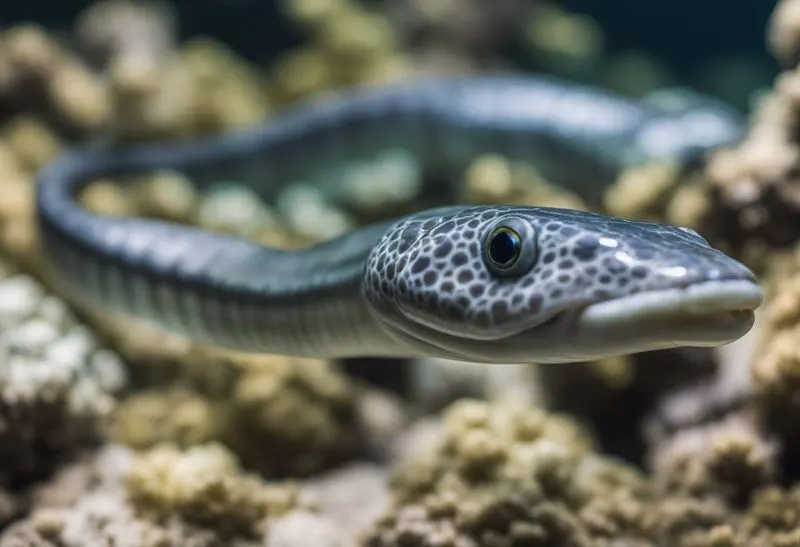
The Grey Conger (Conger cinereus) is an intriguing species of eel found throughout the Atlantic Ocean and the Mediterranean Sea. Reaching lengths of three to five feet, these eels stand out due to their distinct grey coloring and lack of scales, which adds to their unique appearance.
Grey Congers inhabit rocky areas, organizing themselves in elaborate nooks and crannies. Their presence contributes to marine ecosystems, helping maintain a balanced underwater environment. Boasting wide mouths with sturdy teeth, these eels feed predominantly on crustaceans and smaller fish, employing their impeccable hunting skills primarily during nighttime hours.
Grey Conger eels reproduce through broadcast spawning, in which both males and females release their gametes into the water column for fertilization. This reproductive strategy ensures high genetic diversity among their offspring and supports the survival of their species.
Grey Congers have garnered interest in human interaction as both a food source and a game fish; their reputation as a ferocious and determined prey presents an exciting challenge for fishing aficionados. Additionally, these eels have found their way into various traditional dishes, delighting the palates of culinary enthusiasts.
See Related: Different Overfishing Solutions for Conservation
Black Spotted Eel
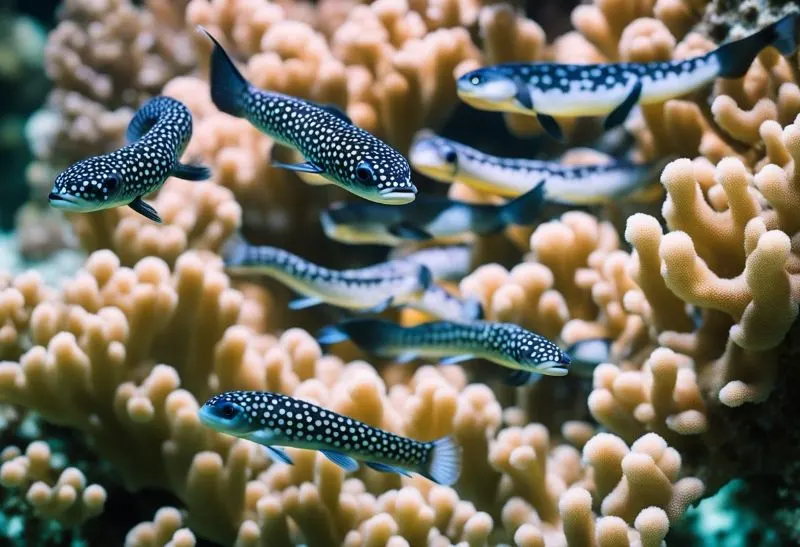
The Black Spotted Eel (Mastacembelus dayi) boasts an exotic and captivating color pattern. Belonging to the spiny eel family Mastacembelidae, this fascinating creature is also known as the Polka Dot Eel and Spotted Spiny Eel. Originating from Southeast Asia, these eels prefer dwelling at the bottom of rivers and streams, where they can easily hide in the substrate.
In appearance, Black Spotted Eels exhibit an elongated body adorned with numerous black spots, giving them their distinctive and attractive look. They can grow up to 20 inches in length, making them a suitable choice for large aquariums where their natural habitat can be mimicked.
When it comes to their behavior, Black Spotted Eels showcase interesting traits. They are mainly nocturnal and prefer hiding in cave-like structures or burying themselves in the substrate during the day. As ambush predators, they feast on small crustaceans and fish, using their elongated snouts to root out prey from hiding spots.
A few key factors should be considered for those interested in keeping Black Spotted Eels in an aquarium. Firstly, their natural habitat must be replicated as closely as possible, with soft substrates and multiple hiding spots provided. They require a diet of live or frozen foods such as shrimp and bloodworms to ensure proper health and growth.
Beach Conger
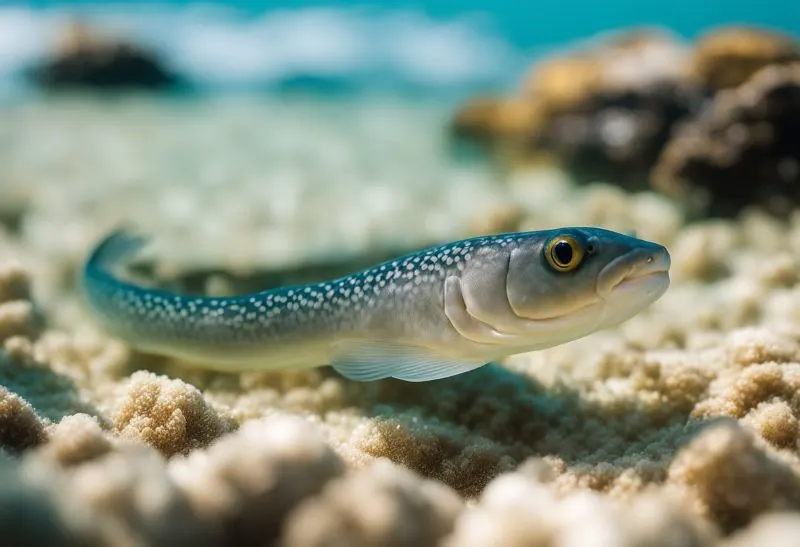
Beach Congers, a type of marine eel, belong to the Congridae family and can be found in various aquatic habitats. These fascinating creatures exhibit a powerful presence with their large heads, gaping jaws, and strong teeth. Often grayish to blackish in color, Congers have paler bellies and fins with black edges, which make them easily distinguishable.
These nocturnal eels boast scaleless bodies, allowing them to slither through sand and rock crevices unseen. Along coastlines, they are frequently found hiding in underwater caves and formations looking for their next meal. Carnivorous by nature, Beach Congers feed primarily on smaller fish and crustaceans, utilizing their razor-sharp teeth for prey capture and consumption.
Adapting to their environment, Beach Congers display a diverse range of sizes. The European Conger, for example, can grow up to 3 meters in length and weigh as much as an adult human. This makes them the largest of the Conger genus. Despite their size and carnivorous nature, these eels pose little threat to humans and are considered non-aggressive.
Beach Congers play a significant role in maintaining the marine ecosystem’s balance. By preying on smaller fish and crustaceans, they help control the population of these species, ensuring a healthy and sustainable ecosystem. Furthermore, Congers serve as a food source for apex predators such as sharks and larger fish.
Longfin African Conger
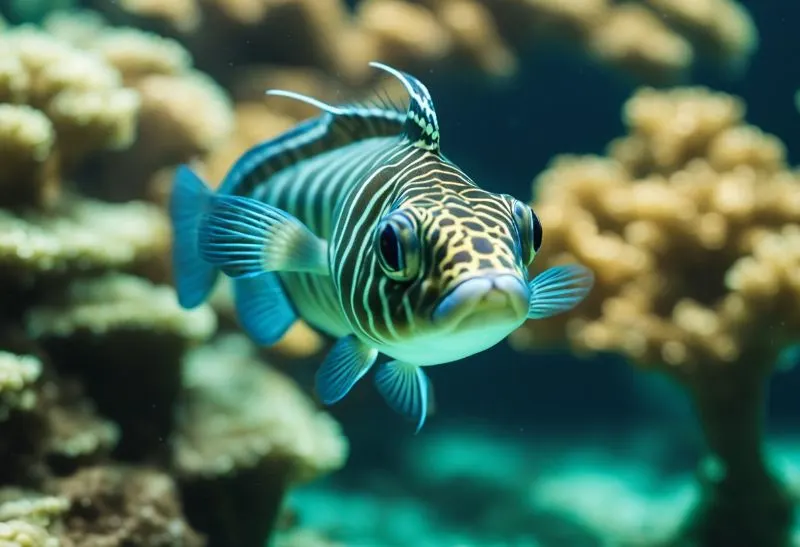
The Longfin African Conger (Conger cinereus) is an eel species belonging to the family Congridae, predominantly found in the Indo-Pacific oceans. Their distribution ranges from the Red Sea and East Africa to the Marquesas and Easter islands, with a presence in northern Australia, southern Japan, and the Ogasawara Islands. These eels commonly inhabit depths of up to 80 meters.
Characterized by their reclusive nature, the Longfin eel and African Congers are seldom spotted during the day. Sporting an elongated, dark brown, or grey body, these eels can grow up to 140 cm in length. Their heads and fins are accentuated by yellow spots, while their bodies feature sharp teeth suitable for their carnivorous diet.
Residing in the diverse marine environments off the coast of Africa, the Longfin African Conger mainly feeds on small fish and invertebrates. Their strong teeth are designed to capture and hold onto prey effectively, facilitating their pursuit of food at greater depths.
While the detailed life cycle and reproductive habits of the Longfin African Conger remain largely undiscovered, the species shares several traits with its fellow Conger eels.
These eels engage in an intriguing migration to spawn, traveling vast distances to reach the preferred breeding grounds. Once the larvae hatch, they will gradually grow into juveniles and eventually mature into adults, continuing the natural cycle of this fascinating species.
Half-Banded Spiny Eel
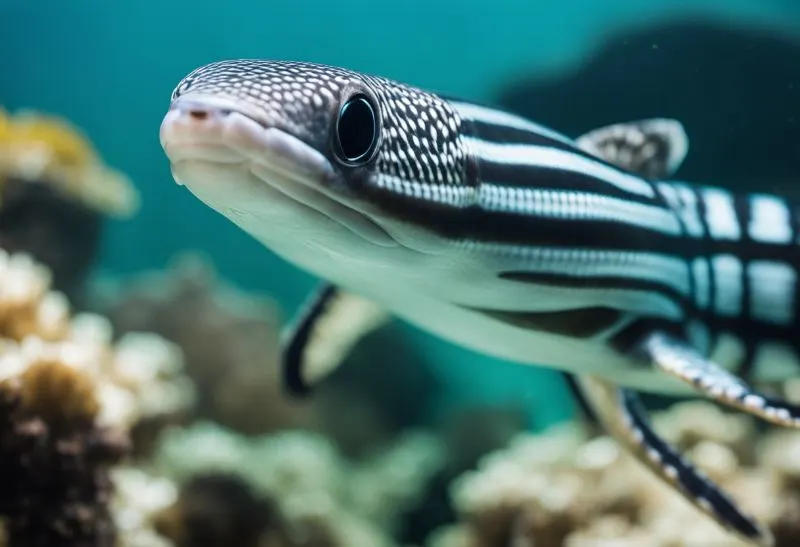
The Half-Banded Spiny Eel (Macrognathus circumcinctus) presents a unique addition to the extensive eel family. Those not acquainted with the Mastacembelidae family may wonder about its true eel status, given the numerous eel-like features. However, a distinguishing characteristic of this species is its elongated body, which concludes with a sharp, pointy snout.
Residing primarily in freshwater environments, the Half-Banded Spiny Eel is smaller than other eel species. Its preferred habitat includes soft sand substrates, allowing it to bury itself when needed. Dense vegetation, caves, and bogwood also provide ideal hiding places and mimic its natural environment.
In terms of care, the Half-Banded Spiny Eel thrives amongst a peaceful community of softwater fish. Its unusual appearance is sure to contribute to an interesting underwater aesthetic. The creature’s diet consists of small invertebrates, worms, and crustaceans, making it crucial for owners to provide sufficient nutrition options for the freshwater eel itself.
Overall, the Half-Banded Spiny Eel demonstrates the vast diversity within the eel family. Its distinct characteristics, combined with its compatibility in a peaceful aquarium setting, make it a fascinating choice for aquatic enthusiasts seeking a captivating, yet manageable, addition to their collection.
Fimbriated Moray
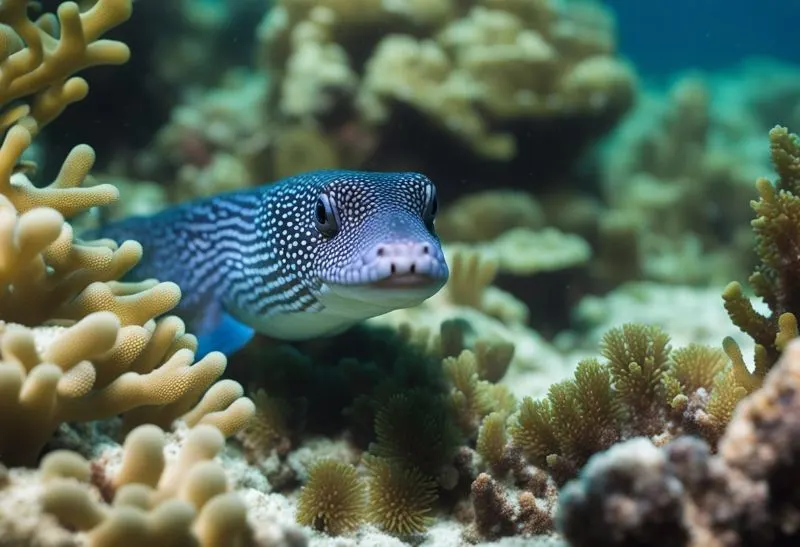
The Fimbriated Moray (Gymnothorax fimbriatus), commonly known as the dark-spotted moray or spot-face moray, belongs to the Muraenidae family of eels. This medium-sized moray eel grows to a maximum length of 80 centimeters (31 inches) and resides in lagoons, reef flats, and seaward reefs.
Fimbriated Morays favor protected waters close to dead corals. They are frequently discovered in small caves and harbors. Distinguished by a unique pattern of dark spots on their body, these eels exhibit a striking resemblance to cheetahs, earning them the nickname “Cheetah Moray.” They are rarely sighted in certain regions, such as Tanzanian waters.
Featuring a wide distribution, moray eels are divided into approximately 202 known species, spread across 16 genera. Within this diverse group of eels, the Fimbriated Moray is a prime example of adaptability and camouflage, enabling it to thrive in various marine habitats frequented by snorkelers and divers.
See Related: Best Aquaponics in a Greenhouse
Moray and Conger Eels
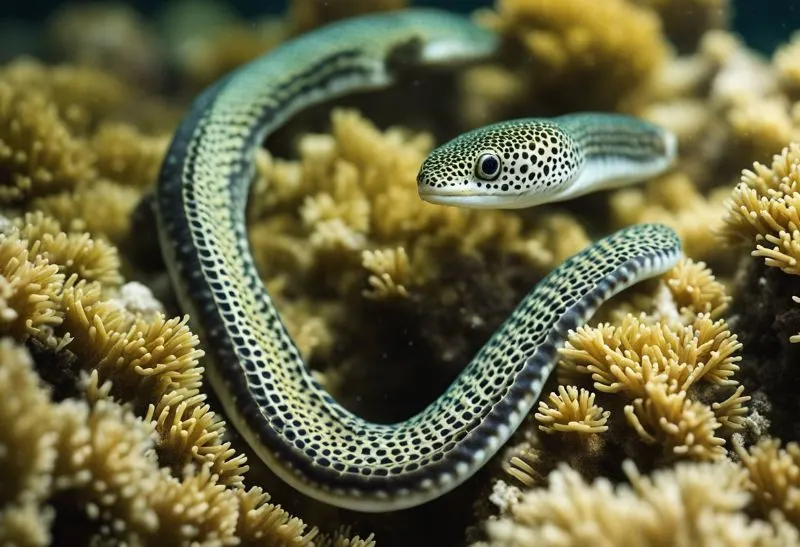
Moray eels, scientifically known as Muraenidae, represent a large family containing about 200 species, found across the globe in marine environments. Their snake-like appearance and intimidating teeth frighten swimmers; however, morays generally behave timidly and bite only in self-defense. A key characteristic of morays is their pharyngeal jaws—an extra set of jaws in their throat—which can extend further than those of other fish.
Conger eels, on the other hand, belong to the family Congridae. The European conger (Conger conger), for example, is known to be one of the largest eel species, found primarily near European coasts. These nocturnal creatures possess a more robust body compared to their moray counterparts and tend to dwell at greater depths, where they prey on a variety of fish and crustaceans.
Both moray and conger eels inhabit reefs, providing shelter and camouflage to ambush their prey. Remarkably, they each hold distinct hunting strategies. Morays employ their long, slender bodies to slither through crevices and snatch their victims, whereas conger eels employ a stationary “sit-and-wait” tactic, striking opportunistically.
Another notable difference between the two is their reproductive process. Female morays release their eggs into the water column, where they will encounter sperm released by males, eventually developing into larvae. Conger eels, conversely, engage in an intricate courtship ritual, during which males and females intertwine their lengthy bodies, enabling the simultaneous release of sperm and eggs.
While electric eels are often lumped together with moray and conger eels, it is essential to note that they belong to a separate family, Electrophoridae, and are predominantly found in South America. As their name implies, electric eels possess electric organs capable of generating powerful electric shocks to subdue prey and protect against threats.
Sawtooth Eel
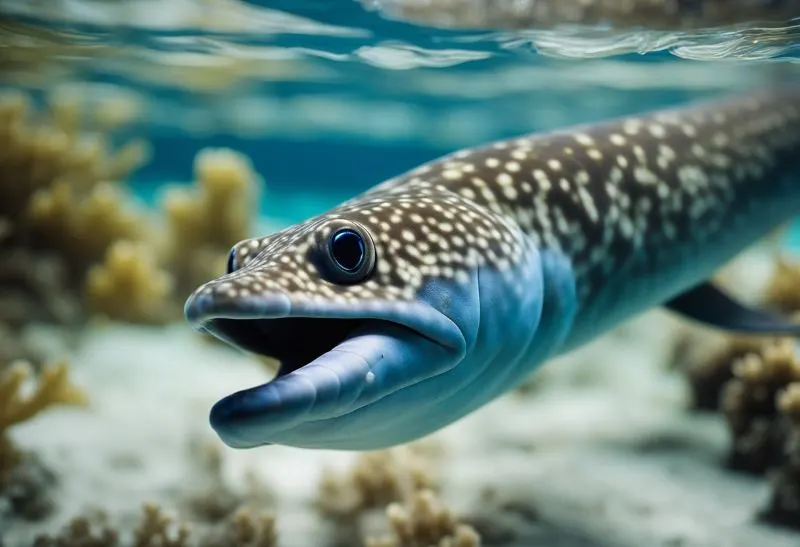
Sawtooth eels belong to the family Serrivomeridae and are characterized by their unique inward-facing teeth that resemble a saw. These deepwater, pelagic eels inhabit the dark depths of the ocean. With 11 known species, sawtooth eels display a range of sizes, typically reaching maximum lengths between 60 to 70 centimeters (23.6 inches to 177.8 inches).
These eels are carnivorous, feeding on various marine organisms in their deepwater environments. Some species, like the Bean’s sawtooth eel (Serrivomer beanii), have also been discovered over a century ago, reportedly first described by Theodore Gill and John Adam Ryder in 1883. The family Serrivomeridae contains two genera: Serrivomer and Stemonidium.
Despite their fascinating appearance, sawtooth eels remain elusive creatures due to their remote locations. Their reproductive and migratory habits are not well-documented, which only adds to their mystique. As ocean dwellers adapted to a unique way of life, sawtooth eels continue to pique the interest of marine biologists and enthusiasts alike.
Snyder’s Moray
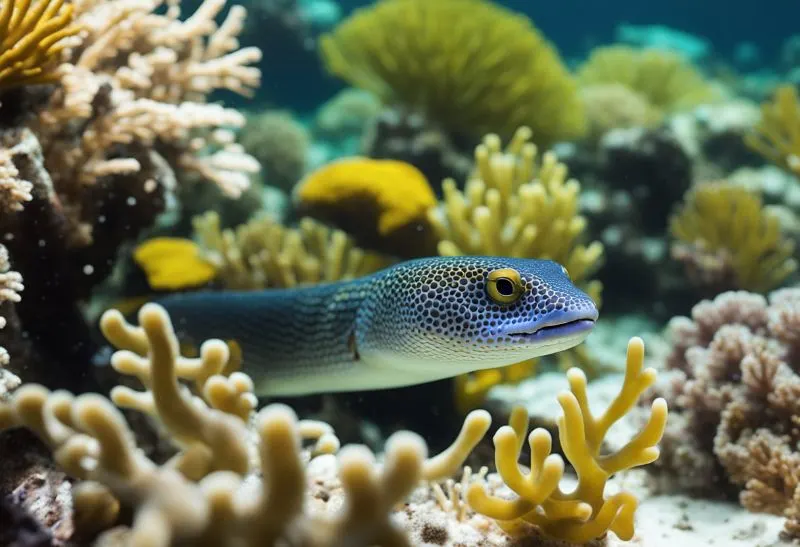
Anarchias leucurus, commonly known as Snyder’s moray, is a unique species of moray eel found primarily in the Pacific Ocean. First identified by Snyder in 1904, this fascinating creature has gained attention due to its smaller size compared to other moray eels. Researchers believe that the finespot moray could represent various subspecies or even distinct species within its classification.
Snyder’s moray boasts an impressive coloration, bearing a medium reddish-brown base hue adorned with brown spots and aggregations of darker markings. Small white spots provide a striking contrast against look like this background, lending to the eel’s popular name as the fine-spotted moray. This particular moray eel inhabits coral reef environments, typically adopting a benthic lifestyle close to the ocean floor.
Interestingly, Snyder’s moray does not stand alone in terms of variety. In fact, the moray eel family (Muraenidae) consists of around 200 species dispersed across 16 genera. While many of these species inhabit both freshwater and saltwater both environments, a select few are deemed suitable for home aquarium settings, and an even smaller number are considered safe for cohabitation with other fish.
Zebra Moray
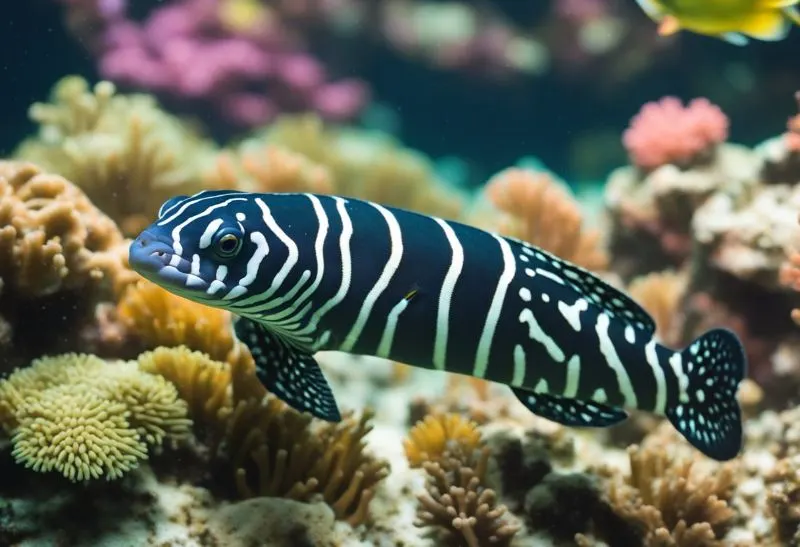
The Zebra Moray (Gymnomuraena zebra) is a unique species of marine fish belonging to the family Muraenidae. It is the sole member of the genus Gymnomuraena, though occasionally it has been classified under Echidna. This medium-sized fish can reach a maximum length of 150 cm, making it impressive in size and appearance.
The Zebra Moray eel exhibits a distinctive dark brown to medium brown coloration, adorned with white stripes or rings, hence earning its name – Zebra. This vivid black and white striped pattern extends along the length of their elongated body. At the tail end, the body flattens, which aids in propelling the eel through water during its nocturnal adventures.
As a nocturnal creature, the Zebra Moray tends to be more reclusive and elusive compared to other moray eels. This eel’s diet primarily consists of crustaceans, making it a carnivore by nature. They utilize their powerful jaws and sharp teeth to crush their prey and feast on the meat within.
When encountering humans, the Zebra Moray is generally shy and fearsome, posing no significant threat unless feeling threatened or cornered. However, their intimidating appearance, snake-like shape, and impressive teeth can lead to unwarranted concerns for swimmers. In reality, most moray eels, including the Zebra Moray, only bite when defending themselves.
In terms of conservation status, the International Union for Conservation of Nature (IUCN) has classified the Zebra Moray as Least Concern. This intriguing creature remains an essential part of the underwater ecosystem, demonstrating a fascinating blend of striking appearance and behavior.
Snowflake Moray
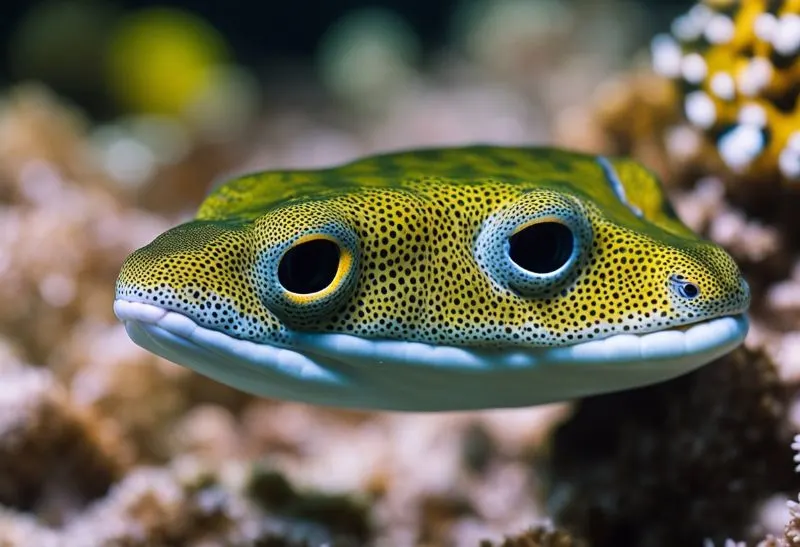
The Snowflake Moray (Echidna nebulosa), also known as the Snowflake eel, Bosch’s eel, clouded moray eel, floral eel, starry eel, or white and zebra moray eel, is a popular marine species found in seagrass beds with rock rubble, intertidal reef flats, tide pools, and rocky shallows. Residing at depths ranging from 1 to 48 meters, they exhibit striking patterns resembling snowflakes, making them an appealing addition to home aquariums.
Reaching an adult size of up to 24 inches, Snowflake Morays are known for their relatively long life expectancy, ranging from 5 to 15 years. They belong to the Muraenidae family, which consists of approximately 200 different species of moray eels, many of which have a snake-like appearance and impressive teeth. Despite their seemingly intimidating presence, most moray eels, including the Snowflake Moray, are shy creatures that bite only when defending themselves.
In aquarium settings, Snowflake Morays are among the most commonly kept saltwater eels due to their hardy nature and adaptability. However, proper care is essential for maintaining their health and longevity. They typically require a spacious, well-maintained tank with hiding spots and secure rocks, along with a balanced diet of nutrient-rich foods, such as fish, shrimp, and squid.
It is important to note that Snowflake Morays are not freshwater eels. In fact, there are only about 15 to 20 species of eels in the Anguilla genus that are considered freshwater eels, including American eels, Moray eels, Spaghetti eels, and European eels. Some freshwater moray eels such as Gymnothorax tile and Gymnothorax polyuranodon can be found in regions like the East Indian Sundaban mangrove swamps, Indonesia, the Philippines, and the Andaman Islands, but these are not synonymous with the Snowflake Moray.
See Related: Are Sharks Tetrapods? Exploring Their Evolutionary Classification
Slender Giant Moray
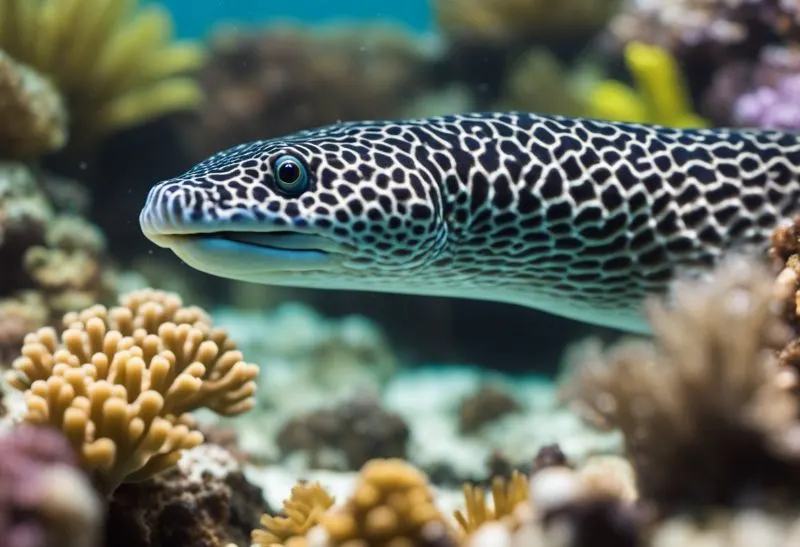
The Slender Giant Moray (Strophidon sathete) stands out as the longest member of the moray eel family. As part of the genus Strophidon, this elongated creature embodies an intriguing facet of marine life.
Habitat for the Slender Giant Moray mainly consists of the Indo-Pacific region and its coastal waters. These eels typically reside within the shallow reef areas but are also known to venture off into deeper parts of the ocean. It is one of the few moray eel species which can be found in freshwater environments as well.
The elongated body of the Slender Giant Moray allows it to navigate within the coral and rocky reefs efficiently. Among other moray eels, its body mass may not be as large; however, it holds the title for the longest body length. To escape predators and ambush prey, the serpentine shape of the Slender Giant Moray equips it with agility and stealth.
Diet-wise, the Slender Giant Moray feeds on crustaceans, fish, and cephalopods. Its powerful jaws and agile body make it a proficient hunter in its underwater realm. Furthermore, the nocturnal nature of this species makes it an efficient predator, as it stalks and captures prey under the cover of darkness.
While there is a myriad of moray eel species, the Slender Giant Moray sets itself apart by showcasing an impressive length and adaptability to various aquatic habitats. As marine ecosystems continue to transform, the Slender Giant Moray serves as a captivating representative of sea life’s evolving complexity.
Ophichthidae
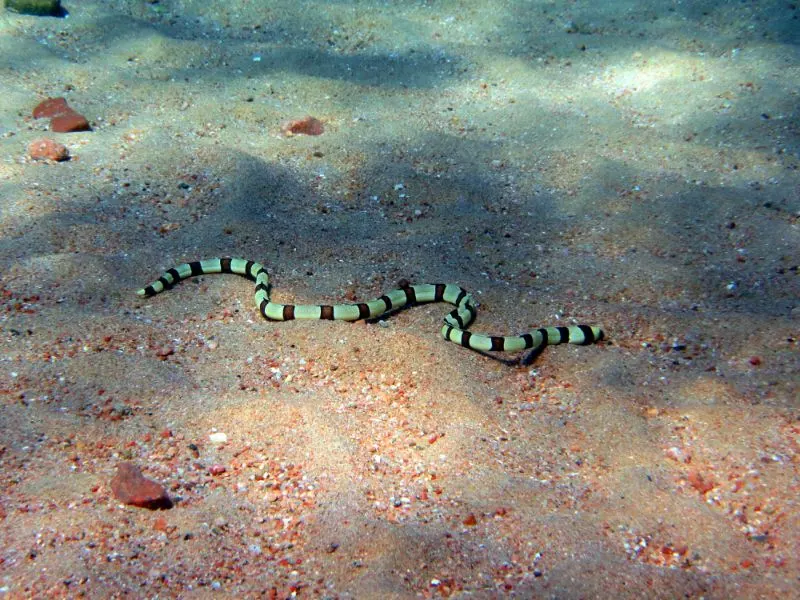
Ophichthidae, a fascinating family of eels, falls under the order of Anguilliformes. These captivating creatures boast long, slender bodies and are commonly referred to as snake eels. These names originate from the Greek words ophis, meaning “serpent,” and ichthys, denoting “fish.” Many of these snake eels exhibit fossorial lifestyles, burrowing into the sediment to hide or find sustenance.
The habitats frequented by snake eels span a range of environments, from shallow coastal waters to deeper ocean depths reaching 800 meters (2,600 feet) or more. Adaptable and hardy, these eels can exist in both freshwater and subterranean environments. Some example genera of snake eels include Monopterus and Ophichthys, native to South Asia.
When it comes to mealtimes, snake eels assume an active predatory role, feeding on a variety of prey such as fish, crustaceans, and mollusks. Their elongated bodies and capability to burrow provide an excellent advantage in capturing prey, while their concealment in the sand or mud offers protection from potential predators.
One distinguishing characteristic of the snake eel is its forked tail. Instead of a typical paddle-like design, this type of eel features a tapering tail ending with sharp, pointy tips. These specialized tails are thought to help ease their passage through cumbersome sediment, aiding in their burrowing lifestyles. Snake eels possess a sensory system called the lateral line, critical for detecting vibrations in the water and enabling them to locate and seize their prey.
Cutthroat Eel
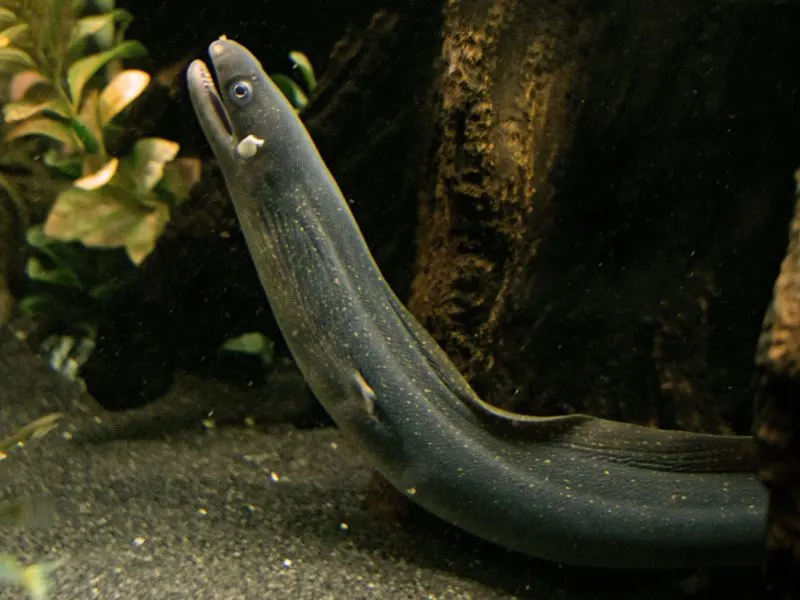
Cutthroat eels belong to the family Synaphobranchidae and are the sole members of the suborder Synaphobranchoidei. These fascinating creatures inhabit temperate and tropical seas across the globe. They vary significantly in size, with lengths ranging from 23 to 160 cm (9.1 to 63.0 in).
Being bottom-dwelling fish, cutthroat eels prefer deep waters, occupying depths of up to 3,700 m (12,100 ft). Adapted to this habitat, they exhibit unique characteristics that set them apart from other eel species. While their scales are few, bilaterally symmetric body and ventrolateral to ventral gill slits contribute to their intriguing appearance.
Inhabiting various parts of the world, including regions such as Mozambique, cutthroat eels display diverse locomotion, employing an anguilliform style of movement. Their geographical distribution extends to both temperate and tropical environments.
It is essential to recognize the unique attributes of the cutthroat eel, as it is just one example within the vast classification of eel species. As a deepwater creature with distinctive characteristics, the cutthroat eel represents an intriguing subject for scientific and environmental exploration.
Whitespotted Conger
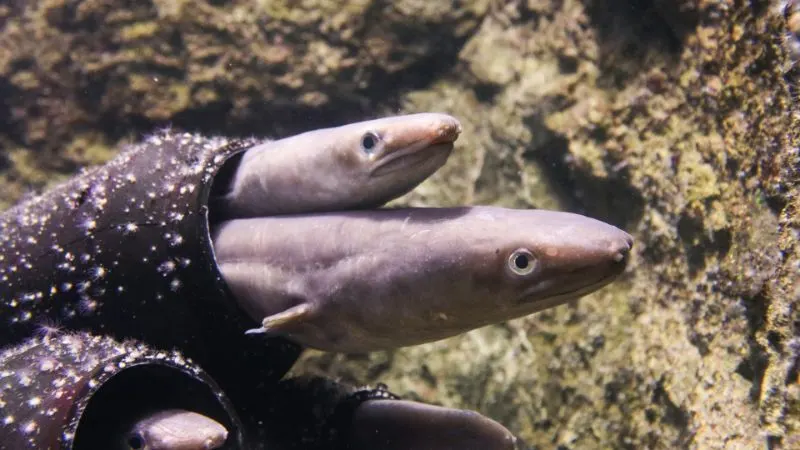
The Whitespotted Conger (Conger myriaster) is a fascinating marine conger eel found primarily in the Northwest Pacific, near the coasts of Japan, the Korean Peninsula, and the East China Sea. Residing in shallow sea bottom sand and mud, these eel species play a distinct ecological role in their habitat.
As a key result of their popularity in the culinary world, Whitespotted Conger has earned its place on several menus in Japan and abroad, where it’s known as “ma-anago” in the Japanese language. In addition to their flavorful taste, these eels’ unique biology is another remarkable aspect of their profile.
Belonging to the family Congridae, these eels showcase anguilliform locomotion, a characteristic mode of movement seen in ray-finned fishes. The body symmetry of Whitespotted Conger is bilaterally symmetric, with a smooth, elongated body structure that allows for graceful and effective movement through their aquatic environment.
Individuals from this fascinating species can reach up to 100 cm in length. Despite their considerable size, they reproduce sexually and contribute to the diverse underwater ecosystem.
See Related: Is a Fish an Animal? Here’s What You Need to Know
Snipe Eel
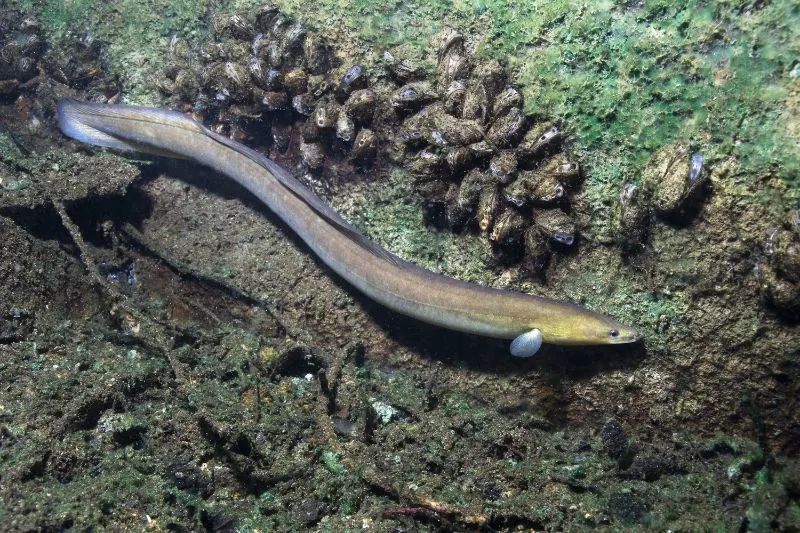
Snipe eels are an intriguing group of deep-sea creatures with snake-like, elongated bodies that make them stand out among other eels. These unique eels belong to the family Nemichthyidae and are known for their highly specialized beaks, reminiscent of a bird. With its beak, it effectively captures prey, primarily consisting of pelagic crustaceans.
Their bodies have evolved to suit the challenging environment of the deep ocean, often stripped of unnecessary parts to adapt to the extreme conditions of the twilight zone. As active predators, snipe eels contribute to the balance of the aquatic ecosystem, which thrives in part thanks to the existence of such creatures.
There are nine different species of snipe eels, some of which include the Avocettina acuticeps or Southern snipe eel, Avocettina bowersii, and Avocettina infans, also known as the Avocet snipe eel. Each of these species, although slightly different in appearance, shares the same characteristic body shape, with some reaching up to 4 feet to 5 feet (1.5 meters) in length.
The feeding process of snipe eels is an interesting phenomenon in itself. Using their bird-like beaks with curving tips and tiny, hooked teeth, these eels sweep through the water column, capturing their prey by entangling the antennae of shrimp. On occasions, larger fishes – including those from shallow waters – prey on snipe eels, showcasing the intrinsic interconnectedness of the marine food chain.
Related Resources:
- Different Animals with No Legs in the World
- What is an Invertebrate? A Concise Overview & Definition
- What is Overfishing? Examples & Solutions to Prevent


